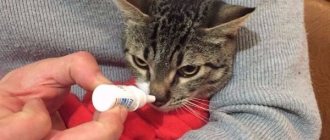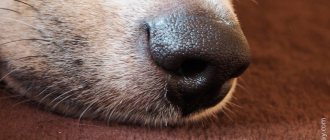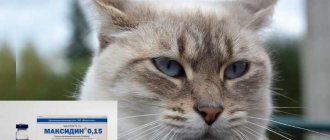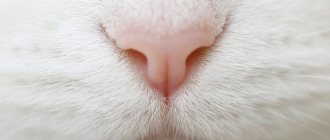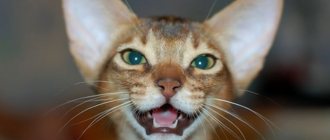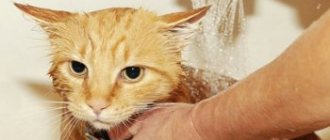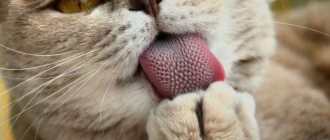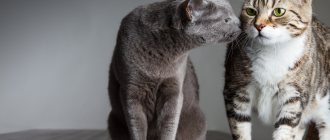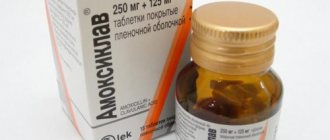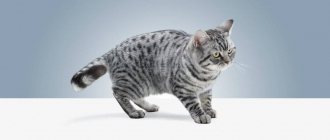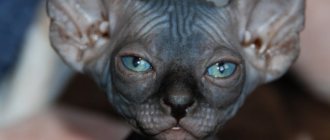10763Pavel
1
Cats, like other pets, are susceptible to infections of various origins and etiologies throughout their lives. In addition to viral-bacterial and invasive diseases, respiratory diseases are very often diagnosed in furry pets. Noticing that a cat has a stuffy nose, this may signal the development of an inflammatory process in the mucous membrane. As a rule, nasal congestion in felines is diagnosed with rhinitis, rhinotracheitis, and also if the pet is infected with the feline herpes virus.
How to tell if a cat has a stuffy nose
When a pet tries to gasp for air, this is a deviation from the norm. However, at the initial stage, other signs of disease or pathology may be completely absent.
If the owner notices that his pet is breathing incorrectly, you should look for other symptoms:
- the cat sneezes and sniffles;
- constantly rubs his face with his paws;
- becomes lethargic, apathetic;
- eats poorly or refuses food completely.
Often the problem is accompanied by the development of conjunctivitis. The animal's rectal body temperature increases.
Balanced diet
A balanced diet is another important preventive measure. To maintain strong immunity, the animal’s body must regularly receive a sufficient amount of necessary elements. There are 2 options for feeding a cat - give the animal high-quality food or include natural products in the diet.
Note! Experts prohibit putting food from the table into your pet's food bowl. It can harm his health, even if the cat eats it with pleasure.
Differences from a human runny nose
Rhinitis is a disease caused by inflammatory processes affecting the mucous membranes of the nasopharyngeal sinuses.
A characteristic sign of a runny nose is copious discharge from the nostrils. They can be transparent and cloudy, colorless or yellowish-green (sometimes mixed with blood), liquid or viscous-thick.
In cats and humans, the signs of a runny nose are identical.
Rhinitis can be unilateral or bilateral, short-term or prolonged.
The main difference lies in the factors that provoked problems with the nose. If in humans the main reason lies in allergic reactions to irritants and the penetration of a viral infection into the nasopharynx, then in animals the “culprits” are more serious and dangerous.
Allergy
Sometimes nasal congestion can be caused by an allergic reaction. Pedigree animals are more susceptible to various types of allergies. Most often, pets begin to snort and sneeze when in contact with:
- plant pollen;
- dust;
- hot steam;
- food;
- particles of household chemicals;
- flavorings.
If the consistency of the animal's nasal discharge is liquid and transparent, then most likely the cause of nasal congestion is an allergic reaction. A side symptom of the disease is watery eyes. In this case, it is necessary to identify the allergen and remove it from the living space.
If you manage to guess and neutralize the provoking factor, then in the near future the cat will be able to feel significant relief.
In addition, antihistamines can be used as an auxiliary measure for a speedy recovery of the animal (allowed to be used only after being prescribed by a specialist).
Causes of nasal congestion
If your pet is not breathing as expected, you need to figure out what caused it as quickly as possible and begin treatment.
Nasal congestion develops:
when copious secretions thicken and, drying, fill the respiratory passages;- due to swelling of the mucous membrane.
The condition of a cat's respiratory tract is influenced by many factors. Some are external in nature, others should be sought inside the body.
Causes of improper breathing in cats
| Factor | Description |
| Birth defects | Characteristic of certain breeds of cats with a shortened muzzle - Persians, British, etc. With a specific structure of the skull, a narrowing of some areas of the nasal cavity is observed. This deficiency predisposes to the development of infections. |
| Pathogens | Acute respiratory infections are also common in cats. Pets can catch a viral infection, which without appropriate treatment is complemented by a bacterial one. As a result, one disease is joined by others |
| Fungus | Spores that enter the respiratory tract lead to the development of mycoses, in which a runny nose often becomes chronic and the discharge becomes purulent and mucous. |
| Neoplasms | Oncology does not spare animals either. A tumor in the nasal cavity can be suspected by purulent, foul-smelling discharge from one nostril |
| Injuries | The pet can get damage to the mucous membrane in a fight, fall, etc. The wounds bleed, pyogenic microbes get into them |
| Oral diseases | Fistulas on the gums, abscesses of tooth roots and other dental problems provoke swelling of the mucous membrane of the nasal ducts |
| Allergies | They appear more often in purebred cats. Irritants include:
|
| Infestations | Worms often settle in the respiratory tract - they need oxygen to develop. The presence of parasites provokes not only rhinitis, but also pneumonia |
| Foreign objects | More often it manifests itself as unilateral congestion. A foreign body can injure the mucous membrane, a sign of which is bloody discharge. Prolonged presence of an object in the nasal cavity causes purulent inflammation |
| Systemic diseases | Common in elderly cats with weakened immune systems. A characteristic symptom is nosebleeds due to high blood pressure or poor blood clotting |
This problem occurs more often in kittens than in adult cats. This is due not only to the underdevelopment of the immune system.
Babies can catch the infection even during the fetal development phase - from a sick mother.
Possible complications
Untimely therapy (or lack thereof) causes prolonged rhinitis. This, in turn, entails serious complications.
Often nearby organs are involved in the inflammatory process:
- An infection traveling through the nasolacrimal ducts enters the eye sacs and causes conjunctivitis, blepharitis and other ophthalmological problems. Some of them can lead to blindness.
Rhinitis often causes otitis media. This, in turn, leads to deafness in the pet.- The abundance of mucous fluid accumulated in the nasopharynx flows through the respiratory tract into the bronchi, from where the infection enters the lungs. As a result, the cat will develop pneumonia.
- The infection can also “travel” upward: from the clogged maxillary sinuses, the inflammatory process moves to the head, causing inflammation of the brain.
Untimely detected polyps and other neoplasms in the nasal cavity can grow to such a size that they completely block the cat’s breathing.
How to treat an animal
Pets need to be looked after like small children. If a cat has a stuffy nose, it needs to be helped to breathe normally, otherwise the animal will not be able to eat properly and will become even more ill.
But medications intended for improving the health of people are not suitable here - pharmacology has developed special medications for cats, taking into account physiological characteristics.
But the plan of therapeutic measures is completely identical:
- for infectious diseases of a bactericidal nature, the pet will be prescribed a course of antibiotics;
- anti-inflammatory and antipyretic drugs are also used in therapy;
- for allergic rhinitis, avoid contact with the irritant and use antihistamines;
if the cause of a runny nose lies in infestations, deworming is carried out;- when rhinitis is the result of a systemic disease or dental problems, draw up a comprehensive treatment plan and follow it;
- Vasodilator drops will help ease your cat's breathing.
Sometimes doctors prescribe inhalations with essential oils. But here you need to take into account the pet’s predisposition to allergies - a strong smell can provoke swelling of the nasopharynx.
In special cases, surgical intervention will be required. These include injuries, penetration of foreign bodies into the nasal cavity, and neoplasms.
Age characteristics
When choosing medications for the treatment of runny nose in cats, you need to focus not only on the specifics of the medications (human or feline).
It is also important to consider the age of the pet. For example, the concentration of immunomodulators in nasal drops intended for adult animals is dangerous when using such drugs for babies.
All medications used in the treatment of nasal congestion are selected exclusively by a veterinarian. He also prescribes the dosage depending on the animal’s age and physiological characteristics. Pregnant and lactating cats require a special approach.
Home therapy
In addition to the main treatment, cat owners are advised to rinse their pet's nose at home.
This should be done with a syringe without a needle, a pipette, using saline solution or ordinary boiled water. This allows you to soften the crusts formed on the mucous membrane, which are then easily removed with cotton wool.
In case of severe inflammation, it is recommended to supplement the rinse with chamomile decoction. But this is done after the crusts and the bulk of the accumulated fluid are removed from the sinuses.
Only after the described procedures, nasal drops are instilled into the pet’s nose..
Thanks to their narrowing effect, the swelling will quickly subside, the animal will stop sniffling and begin to breathe fully.
It is recommended to fight colds by warming up. A bag of warm sand is placed on the cat’s nose and held there for 15-20 minutes. But if the animal has an elevated body temperature, this method of dealing with a runny nose is excluded.
What drops can I use?
Veterinarians generally do not advise the use of medical vasoconstrictors, but if the animal is having difficulty breathing, there may be no other alternative. The following drugs are considered relatively safe:
- Naphthyzin. Experts recommend using this medicine not in its pure form, but as a mixture with dexamethasone and water in a 1:1:1 ratio. You can drip no more than one drop into each nostril. Frequency of use - maximum twice a day, duration of treatment - no more than two days in a row.
- Protargol. This medicine not only helps relieve nasal congestion by stopping the inflammatory process, but also effectively thins thick purulent exudate. This also makes the cat's breathing easier. Place two drops in each nostril three times a day for up to four days in a row.
Prevention of rhinitis and nasal congestion
There is no escape from congenital pathologies – you will have to put up with defects in the breed and regularly clean your pet’s nose.
Most of the factors that cause a runny nose can be easily avoided by following the rules for caring for animals at home:
- comply with the timing of vaccination of the animal;
- regularly visit a veterinarian to be examined for possible pathologies and neoplasms;
- constantly examine the oral cavity in order to promptly notice a dental problem in your cat;
periodically worm your pet;- provide the animal with a balanced diet;
- exclude contact with irritants;
- Do not allow your pet to become hypothermic.
The premises are regularly wet cleaned. Nasal congestion can occur due to dry air in the house.
Preventive measures
In order to protect the animal, it is necessary to provide it with the necessary care. The cat's body can overcome many diseases on its own if it has a good immune system. Therefore, it is important to adhere to certain rules:
- Make sure your pet eats a balanced diet and gets all the necessary vitamins.
- If your pet has access to the outdoors, it is important that he does not stay in the cold or damp for a long time.
- If there is a sick animal in the house, it must be separated from the rest to prevent infection.
- Regularly perform eye, nasal and ear hygiene.
- Closely monitor your pet's behavior and respond to changes in behavior.
- If you suspect that your cat is sick, be sure to contact a veterinarian.
- Monitor the condition of the animal’s sleeping place, bowl and tray.
If, despite all efforts, the cat still gets sick, then it is better not to try to cure it yourself. You can carry out the procedures at home, but only strictly following the veterinarian’s recommendations. This will protect your pet from complications and possible consequences. Proper treatment can stop the disease, and the animal will be cheerful and active again.
Source: fb.ru
